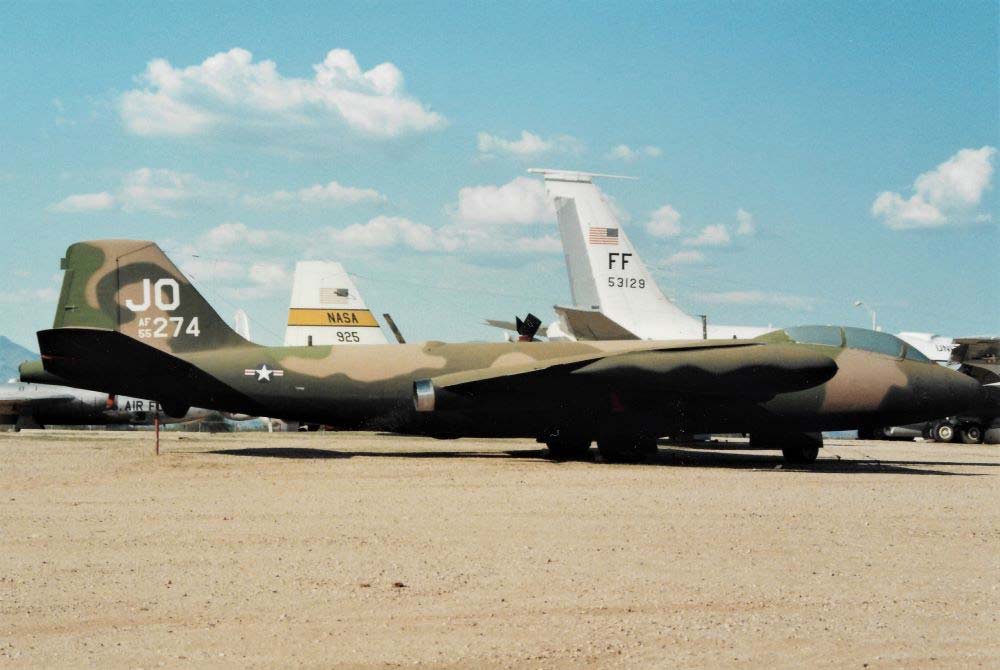The Martin B-57 Canberra was an American-built, twin-engine tactical bomber, renowned for its high-altitude bombing capabilities.
The Martin B-57 Canberra, an adaptation of the British English Electric Canberra, was a versatile American tactical bomber used extensively during the Cold War era. Introduced in the 1950s, it excelled in high-altitude bombing, reconnaissance, and electronic warfare. The B-57 featured a sleek design with swept wings and was one of the first U.S. jets capable of delivering nuclear weapons. Notably used in Vietnam, it demonstrated versatility in various roles, from night-time bombing to weather reconnaissance. The B-57’s legacy lies in its adaptability and effectiveness, marking it as a significant aircraft in the history of U.S. military aviation.
The Martin B-57 Canberra played a crucial role in U.S. aerial operations during the mid-20th century, particularly in the context of the Cold War and Vietnam War.
History of the Development of the Martin B-57 Canberra
In the early years of the Cold War, the United States sought a high-performance, jet-powered bomber to replace older piston-engined bombers. The urgency for advanced bombers was in response to the evolving global geopolitical landscape and the need for a stronger U.S. air presence.
The development of the B-57 Canberra began when the U.S. Air Force showed interest in the British English Electric Canberra, recognizing its potential. The Martin Company was contracted to produce an American version, with significant modifications to meet specific U.S. requirements.
The first flight of the Americanized Canberra occurred on July 20, 1953. While it was primarily used by the U.S. Air Force, it did not have a specific NATO nickname.
Design of the Martin B-57 Canberra
The Martin B-57 featured a mid-wing design with swept wings and tail surfaces, enhancing its high-altitude performance. It was powered by two Wright J65 turbojet engines, an American-built version of the Armstrong Siddeley Sapphire.
The aircraft measured approximately 65 feet (19.8 meters) in length with a wingspan of 64 feet (19.5 meters). Its design prioritized high-altitude flight, with a pressurized cockpit and ejection seats for the pilot and navigator.
The B-57’s design allowed for internal bomb storage and external hardpoints for additional armaments. The adaptation of the British design to American standards involved strengthening the airframe, enhancing the avionics, and improving the engine performance.

Performance of the Martin B-57 Canberra
The B-57’s twin Wright J65 engines provided substantial thrust, enabling a top speed of about 580 mph (933 km/h) and a service ceiling of 48,000 feet (14,630 meters). The aircraft had a maximum range of around 2,700 miles (4,345 kilometers).
When compared with contemporaries like the Soviet Il-28 Beagle, the B-57 boasted superior high-altitude performance, making it effective in its intended roles of bombing and reconnaissance.
Military Use and Combat of the Martin B-57 Canberra
The B-57 Canberra was armed with a variety of bombs, including nuclear weapons. Its versatility was demonstrated in numerous roles: conventional bombing, night-time interdiction, reconnaissance, and electronic warfare.
The aircraft saw significant action during the Vietnam War, conducting bombing missions against enemy supply lines and infrastructure. It was also used for close air support, proving effective in disrupting enemy operations.
The B-57 competed with aircraft such as the Douglas A-26 Invader and the later A-1 Skyraider in terms of close air support capabilities. However, its ability to operate at high altitudes gave it an advantage in certain scenarios.
The Canberra was exported to countries including Australia and Pakistan, serving similar roles. It was phased out of U.S. service in the late 1970s and replaced by more modern aircraft such as the General Dynamics F-111 Aardvark.
The Martin B-57 Canberra was a pivotal aircraft in U.S. military aviation history, showcasing versatility and effectiveness across various roles. Its deployment in conflicts like the Vietnam War underscored its strategic value. While it was eventually succeeded by more advanced technology, the B-57’s legacy endures as a symbol of the U.S. Air Force’s adaptability and innovation in aerial warfare during a critical period of the Cold War.
Back to the Bombers section.